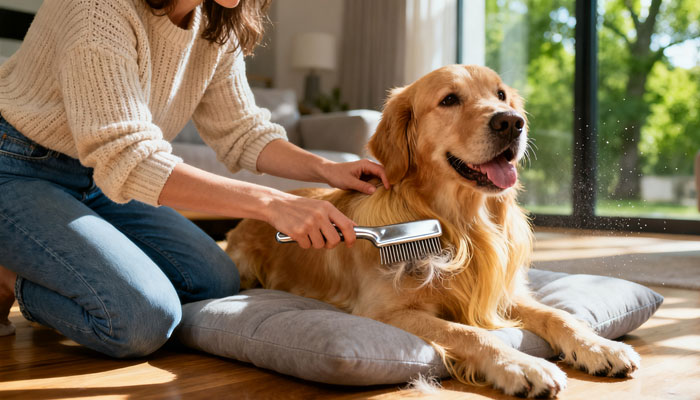Fleas on Dogs: From Identification to Eradication

As temperatures rise, fleas enter their peak breeding season, with summer and fall being the most common times for fleas on dogs. If your dog suddenly starts scratching or biting its skin frequently, with redness, swelling, and an unpleasant odor, it’s most likely fleas on dogs causing the bites! Fleas on dogs not only make dogs restless due to intense itching, but if left untreated long-term, they can lead to skin infections, hair loss, and even anemia. Addressing fleas on dogs promptly is crucial.
I. Quick Identification: 3 Signs Your Dog Has Fleas
To determine if your dog has fleas, no complex tools are needed—daily observation is key. This is the first step in addressing fleas:
Abnormal Behavior: If your dog suddenly scratches its neck, back, or belly frequently with its paws, rubs against floors or furniture, or even chews at its fur, it’s likely due to itching from flea bites. Fleas pierce the skin to feed on blood, and their saliva triggers allergic reactions, causing unbearable discomfort.
Fur and Skin Inspection: Part the fur (especially in hidden areas like armpits and groin, where fleas most commonly congregate). If you spot small black particles (flea droppings; when wiped with a tissue and moistened with water, they turn red due to containing the dog’s blood) or notice small red bumps or scabs on the skin surface, it indicates a flea infestation. Sometimes, with luck, you might even spot sesame-seed-sized brown fleas jumping among the fur.
Environmental Context: If your dog has recently been in grassy areas, bushes, or had contact with other pets that may carry fleas, the likelihood of flea infestation increases significantly. However, there’s no need to worry about fleas on dogs biting humans long-term—fleas rely more on the dog’s fur environment to survive. As long as there’s a dog in the home, fleas on dogs typically won’t stay on humans for extended periods. Still, it’s essential to address fleas on your dog promptly to prevent repeated bites.
II. Prevention First: Follow These 4 Steps to Keep Fleas Away
Instead of waiting until your dog gets infested, take proactive steps to reduce flea breeding opportunities at the source:
Avoid high-risk environments: Fleas lay eggs in damp, dirty areas like rodent-infested corners, stray animal gathering spots, or trash-filled grassy patches. During walks, steer clear of these locations and minimize your dog’s time in tall grass to reduce contact with flea eggs or adults.
Regular grooming to disrupt flea habitats: Brush your dog’s coat at least 1-2 times weekly. This helps detect early flea infestations while removing shed hair and any attached flea eggs. During summer, consider trimming your dog’s coat to deny fleas hiding spots. Monthly bathing with age- and weight-appropriate pet shampoo cleans the coat and keeps skin dry, reducing flea infestation risk.
Thoroughly clean flea-prone items: Dog beds, mats, toys, and leashes serve as hiding spots for flea eggs and larvae. Wash these items weekly with water above 60°C (140°F), then dry them in a high-temperature dryer or expose them to direct sunlight for at least 4 hours. High temperatures effectively kill flea eggs, larvae, and pupae, preventing their cycle of reproduction in your home.
Regular inspections for early detection and treatment: Even with thorough environmental protection, weekly checks of your dog’s coat are recommended, especially during peak flea seasons like summer and fall. If you spot any signs of fleas, take immediate action to prevent infestation and worsening discomfort for your dog.
III. Natural Flea Control: 3 Safe Methods for Effortless Flea Elimination
Chemical flea treatments may irritate puppies, senior dogs, or pets with sensitive skin. For these cases, natural flea control is preferable. U.S. pet expert Carolyn recommends these three simple, effective methods:
Herbal Flea-Repellent Spray: Prepare 200g each of orange peel and grapefruit peel (washed and chopped), 3 garlic cloves (peeled and crushed), and 1 tablespoon rosemary (optional for enhanced repellency). Blend with 500mL water in a juicer until pulpy, then transfer to a small pot. Simmer gently for 15 minutes (avoid boiling to preserve natural repellent properties). . Once cooled, strain out the solids and transfer the liquid to a spray bottle. When using, avoid the dog’s eyes, nose, and mouth. Spray evenly over the dog’s fur (focusing on areas where fleas tend to gather, such as the neck and back). Spray 2-3 times weekly. The herbal scent will repel fleas, effectively eliminating them.
Herbal-Filled Barriers Against Fleas on Dogs: Replace your dog’s bedding, small pillows, or stuffed toys with dried natural herbs like cedar leaves, bay leaves, eucalyptus leaves, or lavender, mint, and wormwood. The natural scent emitted by these herbs strongly repels fleas, forming a protective barrier around your dog to prevent fleas from approaching. The mild herbal aroma won’t irritate your dog’s respiratory tract or skin.
Dietary Support for Flea Prevention: Apple cider vinegar’s acidic properties alter the pH balance on a dog’s skin surface, making it difficult for fleas to attach. Mix 1 teaspoon of apple cider vinegar with 1000mL of cool boiled water and pour into the dog’s water bowl as part of their daily drinking water (ensure plain water is also available nearby to prevent refusal). Consistent consumption not only reduces flea infestations but also helps regulate your dog’s gut flora. If your dog initially dislikes the taste, start with 1/4 teaspoon and gradually increase to 1 teaspoon to allow gradual adaptation, ensuring sustained flea prevention benefits.
admin
-
Sale!

Washable Pet Cooling Pad for Cats and Dogs
$10.99Original price was: $10.99.$9.99Current price is: $9.99. This product has multiple variants. The options may be chosen on the product page -
Sale!

Washable Cat Window Hammock Cooling Bed
$23.99Original price was: $23.99.$22.99Current price is: $22.99. -
Sale!

Tropical Amphibian Rainforest Tank, Lizard Cage
$38.99Original price was: $38.99.$36.99Current price is: $36.99. -
Sale!

Silent 4-in-1 Waterproof Charging Dog Hair Trimmer
$49.88Original price was: $49.88.$47.99Current price is: $47.99.